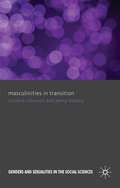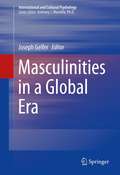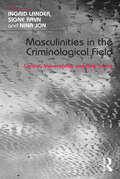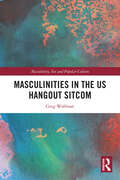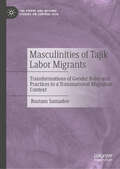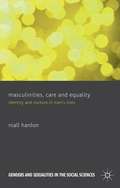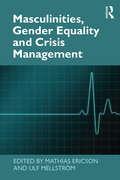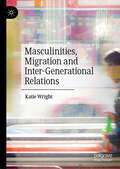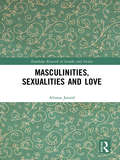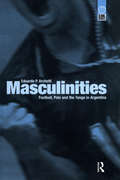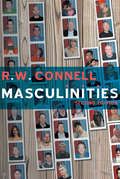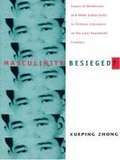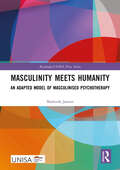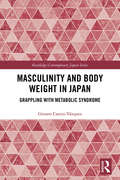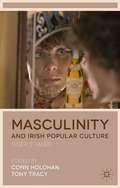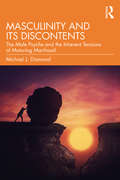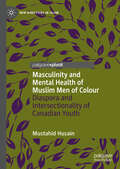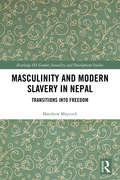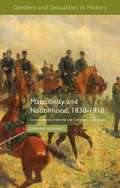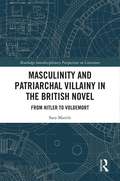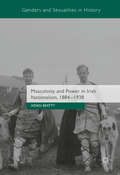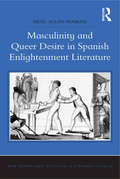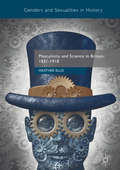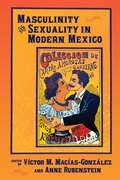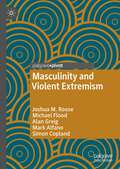- Table View
- List View
Masculinities in Transition
by Victoria Robinson Jenny HockeyContributing to feminist approaches to masculinities, this book examines men's contextual experiences of masculine identity. Drawing on new data which compares men as they move across and between public and domestic spaces, it explores the implications of this for the nature of contemporary masculinity.
Masculinities in a Global Era
by Joseph GelferMasculinities in a Global Era extends the conversation of masculinity studies by analyzing global masculinities from a psychological perspective. Canvassing a broad array of psychological aspects such as the construction of identity, the negotiation of power, coping with trauma, and sexuality, this volume shows how masculinities are experienced, performed and embodied in geographically dispersed communities. Importantly, Masculinities in a Global Era fulfills a much-needed but elusive need within the study of masculinities: a forum in which the often polarized approaches of pro-feminists and men's rights advocates can begin to move beyond their entrenched historical positions towards a more fruitful and nuanced future.
Masculinities in the Criminological Field: Control, Vulnerability and Risk-Taking
by Signe Ravn Ingrid LanderOver recent decades criminological research has changed from a gender-blind discipline which equated crime with men and thus ignored questions about gender, to an approach that studied gender by showing statistical differences between men and women, and then finally to a more inclusive and elaborate gender-theoretical approach to crime and crime control. However, despite this development, research on gender - and in particular research on gendered norms and the construction and enactment of masculinities - within the criminological field has been unable to keep up with developments in gender research. Since 1990, only a few anthologies with a gender-theoretical orientation focusing on masculinities within the criminological research field have been published. Many of the theoretical developments in gender research still have difficulties in reaching into mainstream criminology, partly because such developments are often published in feminist and/or gender theoretical journals. This volume both problematizes and renders visible conceptions and norms regarding male behaviour and masculinities and shows how these affect the criminological field through providing a theoretically sound and clear gender perspective to this field of research. With sections based around the following three themes: negotiations of masculinity in institutional settings, vulnerable masculinities and risk-taking and masculinities, this volume will be of interest to scholars of criminology, sociology, social work and gender studies, as well as policy-makers, and law enforcement professionals.
Masculinities in the US Hangout Sitcom (Masculinity, Sex and Popular Culture)
by Greg WolfmanMasculinities in the US Hangout Sitcom examines how four sitcoms – Friends, How I Met Your Mother, The Big Bang Theory, and New Girl – mediate the tense relationship between neoliberalism and masculinities. Why is Ross in Friends so worried about everything? This book argues that the men in Friends and similar shows that follow young, straight, mostly white twentysomethings in major US cities are beset by a range of social and economic concerns about their place in society. Using multiple methods of analysis to examine these shows – including conjunctural analysis, historiographical method, and critical discourse analysis – a range of topics in these shows are examined, from sexuality through to homosociality, from race through to nationality. This book makes an insightful contribution to work on the television sitcom and on neoliberalism in culture and society. It will be an ideal resource for upper-level undergraduates, post-graduates, and researchers in a range of disciplines including television and screen studies, critical studies on men and masculinities and humor studies.
Masculinities of Tajik Labor Migrants: Transformations of Gender Roles and Practices in a Transnational Migration Context (The Steppe and Beyond: Studies on Central Asia)
by Rustam SamadovThis book explores masculinities of Tajik men and offers insights on how migrant and non-migrant men maintain their gender identity and adjust their gender practices in the context of transnational labor migration from Tajikistan to Russia. Being in the state of transnational in-betweenness, Tajik non/migrant men and often their spouses need to adapt to gender norms of both Russian and Tajik gender orders despite the orders' very different and at times contradicting gender requirements. Therefore, the book provides the first comprehensive analysis of Tajik non/migrant men's masculinities and their navigation between various forms of masculinity: hegemonic, complicit, marginalized, protest and dominant, thereby performing flexible and strategic masculinity. While focusing on migrant men, this research also highlights the role of women in sustaining their partners' masculine image and the ways how Russian women adjust their gender practices in response to the requirements of Tajik society.
Masculinities, Care and Equality
by Niall HanlonMasculinities, Care and Equality explores men's ambiguous relationship with intimate caring work within a context where carefree and nurturing expectations for men are competing for influence. For men, the desire to be more involved carers often clashes with the commonly valued expectations of them as men and this book provides an in-depth, qualitative exploration of a diverse range of male perspectives on the role of love and care in their lives, examining how different men position themselves when confronted by this contradictory expectation.
Masculinities, Gender Equality and Crisis Management (Routledge Key Themes in Health and Society)
by Ulf Mellström Mathias EricsonThe overarching mission of the rescue services comprises three main areas of responsibility: protection against disasters and accidents; crisis management; and civil defence. This mission covers a long chain of obligations in trying to improve societal prevention capabilities and manage threats, risks, accidents, and disasters concerning generic as well as individual safety. It follows a reactive social chain of threat-risk-crisis-crisis management-care-rehabilitation. The authors in this book show that the interesting occupational characteristics of these societal duties are their connection to gender and crisis management in a wider sense. Gendered practices, processes, identities, and symbols are analytical lenses that provide a particular understanding and explanatory base that has received far too little attention in the academic literature. This book identifies four major themes in relation to a gendered understanding of the rescue services, and more generally emergency work: Masculine heroism Intersectional understandings of sexuality, class, and race Gender and technology Gender equality and mainstreaming processes This book shows how the rescue services constitute a productive ground for contemporary gender studies, including feminist theory, masculinity and sexuality studies. Its critical perspective provides new directions for emergency work and crisis management in a broader sense, and in particular for scholars and practitioners in these areas.
Masculinities, Migration and Inter-Generational Relations
by Katie WrightThis book examines father-son relations and their role in the transfer of forms of masculinity and fathering practices. It also explores how far the psychosocial resources transferred from fathers to sons enable sons to navigate challenges in their everyday lives, particularly in contexts of disadvantage and marginalization. This study is a successor to an earlier book examining the inter-generational transfer of human wellbeing amongst Latin American migrant women and their daughters. By extending this analysis to the case of migrant fathers and sons this book explores the impacts of international migration on constructions of masculinity and fatherhood whilst investigating the utility of resources passed intergenerationally in a different social, political and economic environment.
Masculinities, Sexualities and Love (Routledge Research in Gender and Society)
by Aliraza JavaidIt can be said that societies today know little of how gender, sexuality and love interconnect in dissimilar contexts, and how they are collectively shaped by social structures. Underpinned by the theoretical writings of Michel Foucault, Masculinities, Sexualities and Love examines a range of empirical data, including interviews with gay and bisexual men, to understand the ways in which love is constructed and conceptualized. Clearly written, the book is grounded in personal narratives and intimate stories of love, hurt, pain and heartbreak, including the author’s own experiences; and analysed using theoretical frameworks such as hegemonic masculinity, heteronormativity, and post-structuralism. Furthermore, the reader will also find insightful discourse analysis of popular films, such as Fifty Shades of Grey and The Girl on the Train, to examine the construction of love through film. Forming a timely intervention, Masculinities, Sexualities and Love offers a fresh perspective on the sociology of love and will appeal to students and researchers interested in fields such as Gender and Sexuality Studies, Cultural Studies and Sociology.
Masculinities: Football, Polo and the Tango in Argentina (Global Issues)
by Eduardo P. ArchettiThe complex relationship between nationalism and masculinity has been explored both historically and sociologically with one consistent conclusion: male concepts of courage and virility are at the core of nationalism. In this ground-breaking book, the author questions this assumption and advances the debate through an empirical analysis of masculinity in the revealing contexts of same-sex (football and polo) and cross-sex (tango) relations. Because of its rich history, Argentina provides the ideal setting in which to study the intersection of masculine and national constructs: hybridization, creolization and a culture of performance have all informed both gender and national identities. Further, the author argues that, counter to claims made by globalization theorists, the importance of performance to Argentinian men and women has a long history and has powerfully shaped the national psyche. But this book takes the analysis far beyond national boundaries to address general arguments in anthropology which are not culture-specific, and the discussion poses important comparative questions and addresses central theoretical issues, from the interplay of morality and ritual, to a comparison between the popular and the aristocratic, to the importance of ‘othering' in national constructions - particularly those relating to sport. This book represents a major contribution, not only to anthropology, but to the study of gender, nationalism and culture in its broadest sense.
Masculinities: Second Edition
by RW ConnellWhen it was first published over a decade ago, R.W. Connell's ground-breaking text on the nature and construction of masculine identity rapidly became a classic. In Masculinities Connell argues that there is not one masculinity, but many different masculinities, each associated with different positions of power. In a world gender order that continues to privilege men over women, but also raises difficult issues for men and boys, her account is more relevant than ever before. In this new edition, Connell discusses the development of masculinity studies in the ten years since the book's initial publication. She explores global gender relations, new theories, and practical uses of masculinity research. She also addresses the politics of masculinities, and the implications of masculinity research for understanding current world issues. Against the backdrop of an increasingly divided world, dominated by neo-conservative politics, Connell's account highlights a series of compelling questions about the future of human society. Masculinities has been translated into many languages and in 2004 it was voted one of the ten most influential books in Australian sociology. This second edition will be essential reading for students taking courses in gender studies, and a valuable reference for readers across the humanities and social sciences. the fundamental study on masculinity as a formative factor of modern social inequality, and also one of the most important books in the social sciences in recent years'Professor Ilse Lenz, Ruhr University, Bochum
Masculinity Besieged?: Issues of Modernity and Male Subjectivity in Chinese Literature of the Late Twentieth Century
by Xueping ZhongIn Masculinity Besieged? Xueping Zhong looks at Chinese literature and films produced during the 1980s to examine male subjectivities in contemporary China. Reading through a feminist psychoanalytic lens, Zhong argues that understanding the nature of male subjectivities as portrayed in literature and film is crucial to understanding China's ongoing quest for modernity. Before the 1990s onslaught of popular culture decentered the role of intellectuals within the nation, they had come to embody Chinese masculinity during the previous decade. The focus on masculinity in literature had become unprecedented in scale and the desire for "real men" began to permeate Chinese popular culture, making icons out of Rambo and Takakura Ken. Stories by Zhang Xianliang and Liu Heng portraying male anxiety about masculine sexuality are employed by Zhong to show how "marginal" males negotiate their sexual identities in relation to both women and the state. Looking at writers popular among not only the well-educated but also the working and middle classes, she discusses works by Han Shaogong, Yu Hua, and Wang Shuo and examines instances of self-loathing male voices, particularly as they are articulated in Mo Yan's well-known work Red Sorghum. In her last chapter Zhong examines "roots literature," which speaks of the desire to create strong men as a part of the effort to create a geopolitically strong Chinese nation. In an afterword, Zhong situates her study in the context of the 1990s. This book will be welcomed by scholars of Chinese cultural studies, as well as in literary and gender studies.
Masculinity Meets Humanity: An Adapted Model of Masculinised Psychotherapy (Routledge/UNISA Press Series)
by Shahieda JansenIn this book the author, a clinical psychologist, reflects on her psychotherapy experiences with male clients as she debunks the myth of male alexithymia, the inability to recognise and express emotions. Men are apparently disengaged from wellness practices as they are perceived to be reluctant to seek mental health care. An ubuntu-inspired personhood discourse of trust, empathy and transformation theoretically underpins the author’s clinical practice. The integration of the culturally familiar philosophy of ubuntu challenges the hegemony of strictly modern Western psychological discourses and theories. Although the book is not a manual for how to do therapy with men, neither a panacea for all male related challenges, it can ignite empathic insights and kindle gender sensitive responses to male concerns, locally and internationally. Women, who are frequently the targets of gender-based violence primarily committed by men, may play a significant role in the rehabilitation and healing of men. Men are usually excluded from psychosocial interventions, but this book makes the case that prioritsing the wellbeing of boys and men is critical to creating a society that is safe for everyone—men, women, children, and the broader public. Print editions not for sale in Sub-Saharan Africa.
Masculinity and Body Weight in Japan: Grappling with Metabolic Syndrome (Routledge Contemporary Japan Series)
by Genaro Castro-VázquezDrawing on the concept of the somatic self, Castro-Vázquez explores how Japanese men think about, express and interpret their experiences concerning bodyweight control. Based on an extensive ethnographic investigation, this book offers a compelling analysis of male obesity and overweight in Japan from a symbolic interactionism perspective to delve into structure, meaning, practice and subjectivity underpinning the experiences of a group of middle-aged, Japanese men grappling with body weight control. Castro-Vázquez frames obesity and overweight within historical and current global and sociological debates that help to highlight the significance of the Japanese case. By drawing on evidence from different locations and contexts, he sustains a comparative perspective to extend and deepen the analysis. A valuable resource for scholars both of contemporary masculinity and of medical sociology, especially those with a particular interest in Japan.
Masculinity and Irish Popular Culture
by Conn Holohan Tony TracyMasculinity and Irish Popular Culture: Tiger's Tales is an interdisciplinary collection of essays by established and emerging scholars, analysing the shifting representations of Irish men across a range of popular culture forms in the period of the Celtic Tiger and beyond.
Masculinity and Its Discontents: The Male Psyche and the Inherent Tensions of Maturing Manhood
by Michael J. DiamondOffering a uniquely psychoanalytic developmental perspective on male gender identity and the sense of maleness, this book provides an in-depth analysis of the development of masculinity in childhood and its continued evolution throughout a man’s life. Drawing on classical Freudian theory, as well as on more contemporary psychoanalytic theories, this book explores early infancy and child development, preoedipal factors and the oedipal complex, the influence of parenting and the unconscious transmission of gendered factors both by mothers and both biological and symbolic fathers, the male ego ideal, social, cultural, and biological influences, the role of inherent psychic bi-genderality in the context of gender binaries, and the inherent gendered tensions and challenges experienced as an individual progresses into adult and later life. This book is original in its characterization of the male developmental trajectory as underpinned by psychoanalytic principles pertaining to conflict and inherent tensions that continue throughout the life cycle and strongly impact other areas of life. Deeply rooted in the unconscious, a man’s multiply determined sense of masculinity requires deconstructing the mother, the feminine, and the other in the male psyche. As the text illustrates via clinical vignettes, an awareness and an understanding of these areas can improve the clinical work of psychoanalysts working with men who struggle with the intrinsic conflicts in their sense of maleness. This book will be of great clinical value to psychoanalysts, psychotherapists and other mental health practitioners, and will stimulate the thinking of scholars in such areas as gender theory, psychodynamic and sociocultural aspects of gender roles, and the changing social definition of masculinity.
Masculinity and Mental Health of Muslim Men of Colour: Diaspora and Intersectionality of Canadian Youth (New Directions in Islam)
by Mustahid HusainThis book delves into the complexities of masculinity, mental health, and cultural identity among young Bangladeshi-Canadian men. Employing an anthropological, intersectional approach, it scrutinizes the interplay of neoliberal ideologies, Islamic values, and diasporic experiences in shaping their masculine trajectories. The study unravels the intergenerational trauma, parental pressures, and societal expectations that contribute to their deteriorating mental well-being. With a unique insider perspective and rich empirical data, this book fills a crucial gap in the literature by offering invaluable insights for scholars exploring the nuances of migration, ethnicity, gender, and psychological resilience. Strikingly, the author proposes evidence-based interventions and policy recommendations to address the mental health struggles of this underserved population, making it a must-read for academics and students in diaspora studies, migration studies, sociology of race and ethnicity, gender studies, anthropology, political science and development studies, as well as NGOs and policymakers alike.
Masculinity and Modern Slavery in Nepal: Transitions into Freedom (Routledge ISS Gender, Sexuality and Development Studies)
by Matthew MaycockSouth Asia is the region with the highest number of slaves globally according to the Global Slavery Index. Bonded labour affects between 15 and 20 million labourers within the region, and is shaped by locally specific interconnections between ethnicity, class, caste and, critically, gender structures. Masculinity and Modern Slavery in Nepal explores the role of masculinity in shaping the structures and experience of slavery and subsequent freedom. While many I/NGOs and human rights organisations use freedom from slavery as a powerful and emotive goal, the lived reality of freedom for many bonded labourers often results in disappointment and frustration as they navigate diverse expectations of masculinity. Taking Nepal as a case study, the book illustrates how men’s gendered experiences of bondedness and freedom can inform perspectives on the transition to freedom and modernity in South Asia more broadly. Researchers of modern slavery, gender studies, and South Asian studies will be interested in the rich analysis on offer in this book.
Masculinity and Nationhood, 1830-1910
by Josephine HoegaertsA history of what it meant to be a man, and a citizen of an emerging nation throughout the nineteenth century. This book not only relates how Belgians were taught how to move and fight, but also how they spoke and sang to express masculinity and patriotism.
Masculinity and Patriarchal Villainy in the British Novel: From Hitler to Voldemort (Routledge Interdisciplinary Perspectives on Literature)
by Sara MartínMasculinity and Patriarchal Villainy in the British Novel: From Hitler to Voldemort sits at the intersection of literary studies and masculinity studies, arguing that the villain, in many works of contemporary British fiction, is a patriarchal figure that embodies an excess of patriarchal power that needs to be controlled by the hero. The villains' stories are enactments of empowerment fantasies and cautionary tales against abusing patriarchal power. While providing readers with in-depth studies of some of the most popular contemporary fiction villans, Sara Martín shows how current representations of the villain are not only measured against previous literary characters but also against the real-life figure of the archvillain Adolf Hitler.
Masculinity and Power in Irish Nationalism, 1884-1938
by Aidan BeattyThis book is a comparative study of masculinity and white racial identity in Irish nationalism and Zionism. It analyses how both national movements sought to refute widespread anti-Irish or anti-Jewish stereotypes and create more prideful (and highly gendered) images of their respective nations. Drawing on English-, Irish-, and Hebrew-language archival sources, Aidan Beatty traces how male Irish nationalists sought to remake themselves as a proudly Gaelic-speaking race, rooted both in their national past as well as in the spaces and agricultural soil of Ireland. On the one hand, this was an attempt to refute contemporary British colonial notions that they were somehow a racially inferior or uncomfortably hybridised people. But this is also presented in the light of the general history of European nationalism; nationalist movements across Europe often crafted romanticised images of the nation's past and Irish nationalism was thus simultaneously European and postcolonial. It is this that makes Irish nationalism similar to Zionism, a movement that sought to create a more idealized image of the Jewish past that would disprove contemporary anti-Semitic stereotypes.
Masculinity and Queer Desire in Spanish Enlightenment Literature (New Hispanisms: Cultural and Literary Studies)
by Mehl Allan PenroseIn Masculinity and Queer Desire in Spanish Enlightenment Literature, Mehl Allan Penrose examines three distinct male figures, each of which was represented as the Other in eighteenth- and early nineteenth-century Spanish literature. The most common configuration of non-normative men was the petimetre, an effeminate, Francophile male who figured a failed masculinity, a dubious sexuality, and an invasive French cultural presence. Also inscribed within cultural discourse were the bujarrón or ’sodomite,’ who participates in sexual relations with men, and the Arcadian shepherd, who expresses his desire for other males and who takes on agency as the voice of homoerotica. Analyzing journalistic essays, poetry, and drama, Penrose shows that Spanish authors employed queer images of men to engage debates about how males should appear, speak, and behave and whom they should love in order to be considered ’real’ Spaniards. Penrose interrogates works by a wide range of writers, including Luis Cañuelo, Ramón de la Cruz, and Félix MarÃa de Samaniego, arguing that the tropes created by these authors solidified the gender and sexual binary and defined and described what a ’queer’ man was in the Spanish collective imaginary. Masculinity and Queer Desire engages with current cultural, historical, and theoretical scholarship to propose the notion that the idea of queerness in gender and sexuality based on identifiable criteria started in Spain long before the medical concept of the ’homosexual’ was created around 1870.
Masculinity and Science in Britain, 1831–1918
by Heather EllisThis book offers the first in-depth study of the masculine self-fashioning of scientific practitioners in nineteenth and early twentieth-century Britain. Focusing on the British Association for the Advancement of Science, founded in 1831, it explores the complex and dynamic shifts in the public image of the British 'man of science' and questions the status of the natural scientist as a modern masculine hero. Until now, science has been examined by cultural historians primarily for evidence about the ways in which scientific discourses have shaped prevailing notions about women and supported the growth of oppressive patriarchal structures. This volume, by contrast, offers the first in-depth study of the importance of ideals of masculinity in the construction of the male scientist and British scientific culture in the nineteenth and early twentieth centuries. From the eighteenth-century identification of the natural philosopher with the reclusive scholar, to early nineteenth-century attempts to reinvent the scientist as a fashionable gentleman, to his subsequent reimagining as the epitome of Victorian moral earnestness and meritocracy, Heather Ellis analyzes the complex and changing public image of the British 'man of science'.
Masculinity and Sexuality in Modern Mexico (Diálogos Series)
by Anne Rubenstein Víctor M. Macías-GonzálezIn Masculinity and Sexuality in Modern Mexico, historians and anthropologists explain how evolving notions of the meaning and practice of manhood have shaped Mexican history. In essays that range from Texas to Oaxaca and from the 1880s to the present, contributors write about file clerks and movie stars, wealthy world travelers and ordinary people whose adventures were confined to a bar in the middle of town. The Mexicans we meet in these essays lived out their identities through extraordinary events--committing terrible crimes, writing world-famous songs, and ruling the nation--but also in everyday activities like falling in love, raising families, getting dressed, and going to the movies. Thus, these essays in the history of masculinity connect the major topics of Mexican political history since 1880 to the history of daily life.Part of the Diálogos Series of Latin American Studies
Masculinity and Violent Extremism (Global Masculinities)
by Mark Alfano Michael Flood Joshua M. Roose Alan Greig Simon CoplandThis book explores men's attraction to violent extremist movements and terrorism. Drawing on multi-method, interdisciplinary research, this book explores the centrality of masculinity to violent extremist recruitment narratives across the religious and political spectrum. Chapters examine the intersection of masculinity and violent extremism across a spectrum of movements including: the far right, Islamist organizations, male supremacist groups, and the far left. The book identifies key sites and points at which the construction of masculinity intersects with, stands in contrast to and challenges extremist representations of masculinity. It offers an insight into where the potential appeal of extremist narratives can be challenged most effectively and identifies areas for both policy making and future research.
